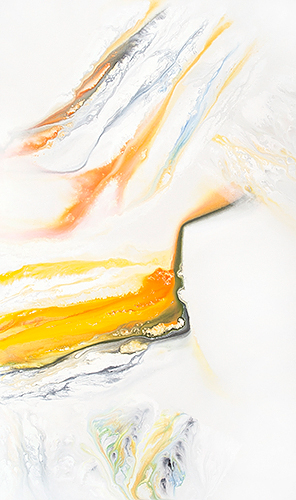Aesthetics of the fluids
by Christine Frérot
(translated from Portuguese by Beatriz Viégas-Faria)
Published in the catalogue of the solo exhibition at the D'Est et D'Ouest Art Gallery,Paris, France, 2011.
“Painting celebrates no other enigma but that of visibility. “ (1)
M. Merleau-Ponty, «The Eye and the Spirit», 1964.
The work on formlessness that has been carried out by Manoel Veiga since the 1990s is closely related to the notions of space and time which – together with his research work on transparency – comprise its experimental matrix. Whether in the black and white photographs (the “Hubble” series), that he exhibits now for the first time, or in his most recent acrylic paintings (no titles, and therefore numbered), his work process responds to various rational demands of a technical order – perhaps evoked by his previous education as an engineer – that combine firstly with his desire to explore matter, secondly with the portion of his work that is left in the random hands of chance, then with the meandering freedom of the liquids, and finally with a search for beauty. On his canvases, the artist employs a vaporizer, rather than brushes, and he uses his sound knowledge of chemistry to put forward a wise control of the liquid flows. As for the photographs, they receive further treatment in the computer, and this is based in clichés of galaxies that he collects on the internet. On observing Veiga’s works as the adventures of the matter that they truly are, it is hard not to link his plastic universe to the inheritance left by the painters of the informal that championed, half a century ago, a rupture with the preliminary drawing, the supreme authority of gesture and matter, thus rejecting the work of art as representation.
It is not therefore in the realm of metaphors that one should try to understand the aesthetical thinking of Manoel Veiga, but rather in the visual experience. By favoring seeing and feeling, one can perceive the phenomenological and the poetical dimensions that operate in him. The permanent exploration of movement gives rise to an interrogation about the link between spirit and nature, between hidden and revealed, between space as idealized and space as experienced. This is how the aesthetic pictorial imagined world of the artist finds its place in the core of the dialectics of outside and inside, as evoked by philosopher Gaston Bachelard: Veiga mixes interior and exterior, he associates and intertwines fragile masses and arachnean dilutions, he opposes shadow and light, implosion and explosion. Veiga’s controlled gestural language attempts at solving the contradictions of the matter, and in order to imprint some degree of order in chaos, he turns into this demiurge of a creation that goes beyond nature. His painting develops within a dynamics of the intimate, it irrigates the entre-deux previously virgin of any intervention – connected to the preparation of the canvas. Between reason and passion, between adventure and experimentation, between speculation and manipulation, he tries to create another type of “nature”, he invents an organic landscape between fire, flesh, water, and air, and these are constantly restructured, and he does so just like an alchemist for whom the conquest of the pictorial space is the ultimate challenge.
The gestural mastership of the painter raises several questions and observations. The idea of the relations between science and nature, or between science and poetry, is put forward as the core of the artwork where form and knowledge are so completely and inextricably fused. The outpour, the flowing and drainage, the whirlpools, the dilutions, the effusion, the dispersion, and the scratches, all of these create a rhythm that is almost audible, that bring a certain musicality to the artwork. Two natural elements, “fire” and “water,” in the origin of dissolution and deletion, introduce yet another place – more archaic, – the space of nearly visible transparency where the objective and subjective pure zones of his creation are structured. The aquatic cosmogony of the Aztecs associates water and fire, and they have a hieroglyph that means “war,” where the two elements are shown face to face. In Manoel Veiga’s work, there is no struggle, but rather a friction that is subtle and delicate, sometimes interrupted, often dilacerated. This is a world where “accidents,” from form to color, play an essential role and force the painter to unveil a vaster universe – by granting him entrance into an ampler horizon, by constantly challenging him to deal with limits while taking notice of the limits of the canvas.
When cosmic hierogamy (the marriage between heaven and earth) was mentioned above, this was done in order to tackle the idea of the “empty median” as developed by Chinese writer François Cheng:* the souffle (respiration and inspiration), the locus of vital circulation where the processes of interaction and mutual transformation take place.
Manoel Veiga’s very personal aesthetics could be linked to this philosophy of the landscape, for the yubai is the “white” that is voluntarily “left” in the image landscape in order to instigate the imagination of the viewer.** By adding water to nature, the artist takes a step towards both the Buddhist philosophy and the Chinese landscape; moreover, he produces a visceral geomorphology – and what is organic turns into flesh. The “actual movement where nature is being constructed”*** between thought and matter may also translate to Veiga as solitary beauty.
*Le dialogue, François Cheng, Desclée de Brouwer, Paris 2002, p.15.
**Les raisons du paysage, Augustin Berque, Hazan, Paris 1995, p.76.
***Manoel Veiga, Recife (Brazil), January 2011.
**Les raisons du paysage, Augustin Berque, Hazan, Paris 1995, p.76.
***Manoel Veiga, Recife (Brazil), January 2011.

